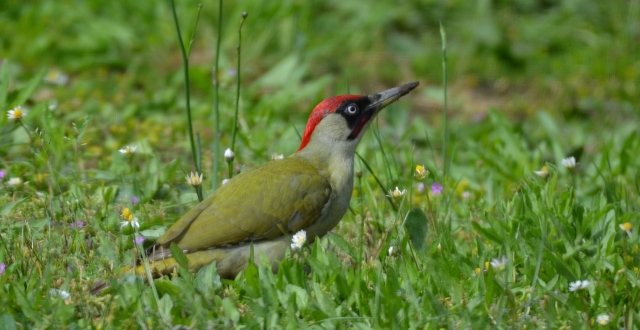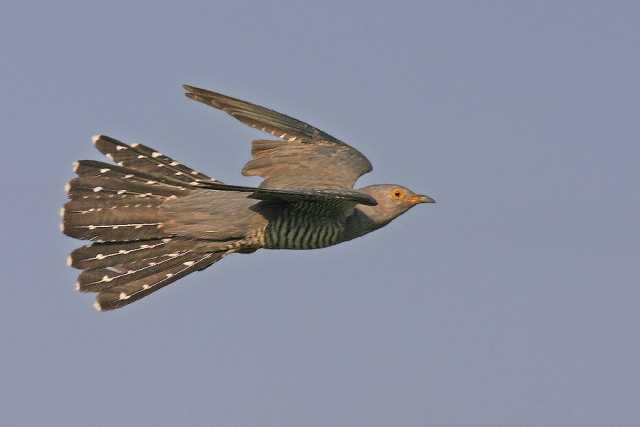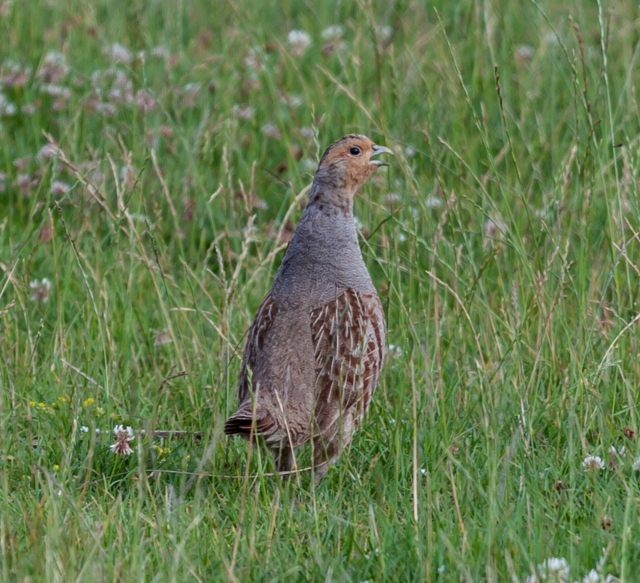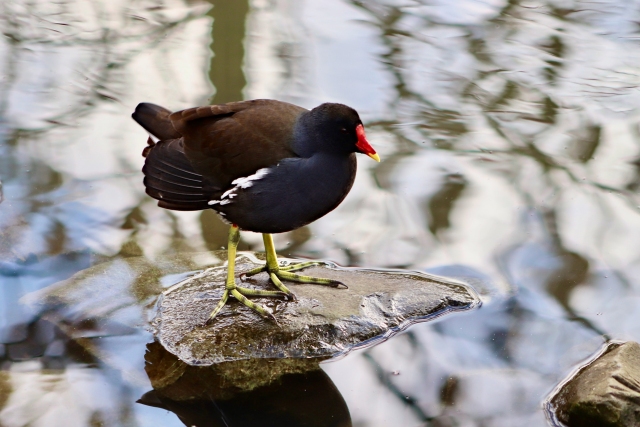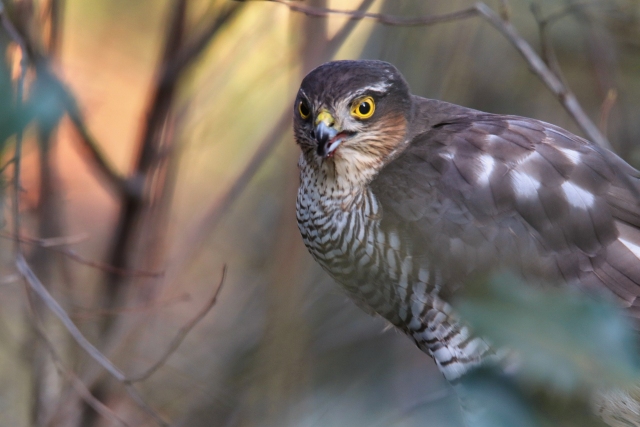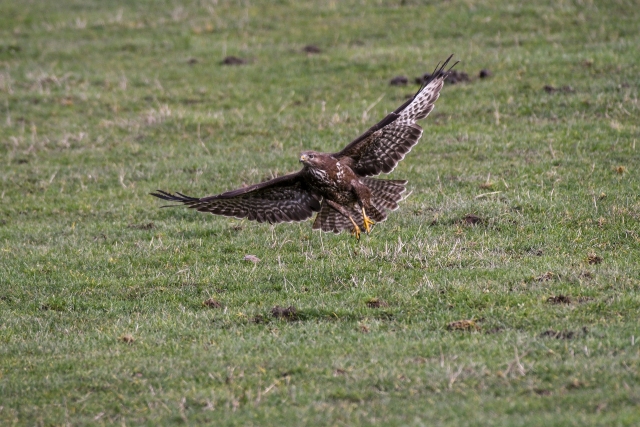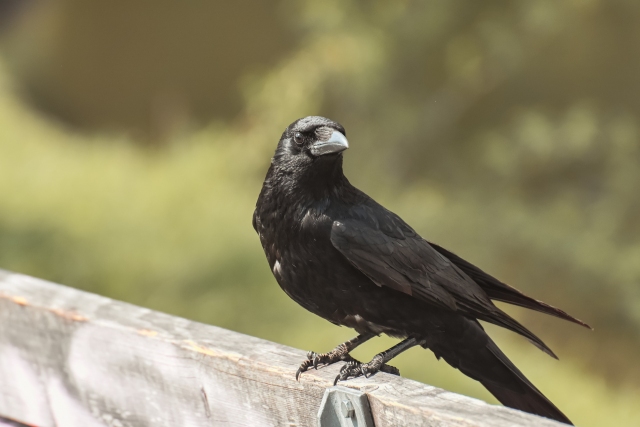Florian Heigl
European green woodpecker
Description
The green woodpecker reaches a length of 32 centimeters and has a wingspan of up to 52 centimeters. The upperpart is dark green, the underpart is pale light to gray-green in colour. The sides of the head are marked by a black facial mask that extends from the beak to behind the eyes. The top of the head and the nape of the neck are red, the rump is greenish-yellow. The ear area, chin and throat, on the other hand, are whitish. The wings are brown-black, yellowish or brownish-white spotted. The rectrix are blackish banded on a greenish-gray ground. The differences between the sexes are slight, in the male the cheek patch is red with a black edge, in the female this cheek patch is solid black. The eyes of the green woodpecker are bluish-white, and the beak and feet are lead-gray. Males and females are the same size and weight.
The juvenile plumage differs greatly from adult plumage, being distinctly duller overall. The sides of the head, neck and underparts are heavily dark spotted to banded on an almost white ground. The red parts of the head colouration are inconspicuous and mostly interspersed with gray spots. The wings and the upperparts also show a distinct white mottling.
In Central Europe, the European green woodpecker can only be confused with the somewhat smaller but otherwise very similar gray woodpecker. Unlike the green woodpecker, however, the grey woodpecker has a gray head, a dark red eye, and only a narrow black chin stripe. The grey woodpecker also lacks the red crest of the green woodpecker, only the male has a red forehead, while the female lacks a red head mark. Often already the place of observation gives clues for species identification, the grey woodpecker is missing in the northwest of Central Europe and is much more bound to mountains and to forest compared to the green woodpecker.
Habitat
It prefers semi-open landscapes with extensive old woods, especially forest edges, copses, meadows, parks, groves and large gardens with trees. Within extensive woodlands, it only occurs in heavily cleared areas, forest meadows and larger clearings. The species shows a strong preference for deciduous forests; in extensive coniferous forests it can be very rare or absent over large areas.
Due to its strong specialization on ground-dwelling ants, the green woodpecker is susceptible to severe winters with high snow levels. Its main distribution area is therefore the lowlands and the lower altitudes of the low mountain ranges up to an altitude of about 500 m above sea level.
In the Alpine region, this limitation of distribution with regard to sea level does not exist. In the Bavarian Pre-Alps and Alps, the Green Woodpecker inhabits all altitudes from 600 to 1400 m above sea level quite evenly and has been recorded up to 1700 m above sea level.
The text is a translation of an excerpt from Wikipedia (https://de.wikipedia.org/wiki/Grünspecht). On wikipedia the text is available under a „Creative Commons Attribution/Share Alike“ licence. Status: 17 December 2021
Northern lapwing
Description
The northern lapwing reaches about the size of a pigeon at 28 to 31 centimeters in body length, and has a wingspan of 70 to 80 centimeters. Adult northern lapwings have a shimmering metallic green-gray mantle with a blue-purple shoulder patch. The belly is white in colour with a black, sharply defined breast band. The head is white with a black forehead that ends in a long two-tipped cap, called a Holle. Starting from the black beak, a blurred black band runs under the eye to the back of the head. The abdomen is washed out sandy to rusty orange in colour. In nuptial plumage, the male differs from the female only by a longer crest, a somewhat more intense black colouration, and the continuous throat patch. For a plover, northern lapwings have comparatively short legs, which are coloured dark red to brown.
In basic plumage, the chin and fore-neck are white in both sexes. The feathers of the upper hand coverts and shoulders are fringed with pale yellowish brown, creating a scale-like pattern. The crest is noticeably shorter than in breeding plumage. Juvenile lapwings look like adults in basic plumage, but also have broader, yellow-brown feather fringes as well as a distinctly lighter, brown-coloured breast band.
Habitat
Northern lapwings breed primarily in open, flat landscapes with short grass or no grass at all, in meadows and pastures, preferably along the edges of water bodies, on wet meadows, heaths and moors. Northern lapwings also breed in fields. During winter and the migratory season, the birds also stay in harvested fields and plowed fields. In winter, northern lapwings can be seen widely dispersed on old pastures, but also as troops on muddy areas.
The text is a translation of an excerpt from Wikipedia (https://de.wikipedia.org/wiki/Kiebitz_(Art)). On wikipedia the text is available under a „Creative Commons Attribution/Share Alike“ licence. Status: 17 December 2021
Common cuckoo
Description
With a wingspan of 55 to 60 centimeters and a body length of 32 to 34 centimeters, the common cuckoo is almost as large as a turtle dove, but more delicate and slender. The weight of the male is 110-140 grams, the female 95-115 grams. The wings are pointed and the rounded tail is 13-15 centimeters long. In flight, the species looks similar to a sparrowhawk, but has more pointed wing tips. When sitting, the common cuckoo appears short-legged. The stepped tail is not infrequently fanned and slightly raised, and the wings are often left hanging somewhat splayed.
Adult males are slate gray on the upperparts. The uppertail coverts have light gray, very thin, narrow terminal seams. The chin, throat, sides of the neck, and forechest are uniformly light gray and lighter than the upperparts; the rest of the underparts are white with broad grayish-brown banding. The undertail coverts are white to isabelline. The tail is dark slate gray with a distinct white terminal fringe. The iris, eyelid ring, and beak base are pale yellow.
Adult females appear in two colour morphs. The gray morph closely resembles males, but shows a rusty beige to yellowish tint on the breast and a thin dark cross banding. The brown morph is rarer and is rusty brown on the upperparts and breast. The entire plumage is dark cross banded. The tail is brown and dark banded with a thin white terminal band. The iris, eyelid ring, and beak base are light brown.
The juvenile birds are slate gray, sometimes with a rusty brown tinge. The entire plumage is thinly dark cross-banded. The small and large wing coverts have narrow white fringes. The iris is dark brown, the eyelid ring is pale yellow, and the base of the bill is pale. Juvenile birds can be identified by the white patch on the nape.
In both morphs and in juvenile plumage, the legs are yellow and the beak is horn-gray except for the base.
Habitat
It inhabits cultivated landscapes as well as biotopes above the tree line, the dunes of the sea coasts and almost all habitats in between: sparse deciduous and coniferous forests, swamp forests or even upland moors and steppes. It does not occur in the Arctic tundra and in extensive dense forests. The occurrence of the birds that serve as hosts for it during reproduction is crucial. In its habitat there must be sufficient small structures such as shrubs, hedges, scattered trees and perching opportunities. It is also found in the outskirts of cities.
The text is a translation of an excerpt from Wikipedia (https://de.wikipedia.org/wiki/Kuckuck). On wikipedia the text is available under a „Creative Commons Attribution/Share Alike“ licence. Status: 17 December 2021
Common partridge
Description
The common partridge, like all members of the genus, is of stocky build with short legs, short round tail and short round wings. The orange-brown head, light gray forebody and reddish-brown lateral banding are characteristic. The tail, with the exception of the central rectrix, is vivid russet. There is a more or less pronounced dark brown patch in the shape of a horseshoe at the center of the lower breast, sometimes absent in females and often much smaller. In spring and summer the common partridge wears the nuptial plumage, in autumn and winter the basic plumage. The straight beak is yellow and brown or gray at the base. Common partridges have a body length of about 30 centimeters, a wing length of 14.6 to 16 centimeters, and a tail length of 7.2 to 8.5 centimeters. Males and females are similar in size; however, the latter are slightly heavier. Body weight ranges from 290 to 415 grams for males and 300 to 475 grams for females.
Habitat
The common partridge lives mainly in lower altitudes below 600 m, but it can also be found in higher altitudes of the low mountain ranges and alpine valleys. The original habitats were steppes, especially tree and shrub steppes. Due to their high adaptability, common partridges are synanthropic birds and live in heaths as well as on arable land, grassland and fallow land, herbaceous meadows and in richly structured mixed areas. In warmer areas with fertile soils the highest population densities are reached. Optimal habitats are characterized by alternating multi-crop agricultural use with hedgerows, shrubs, field and road margins, offer small-scale structured plots and have little forest cover. Necessary cover is provided by a high proportion of boundary lines. Boundary lines are characterized by many hedge strips and thus much cover. Stubble fields and fallow land are very popular as resting and feeding places. Areas with winters with little snow are clearly preferred. Root crop fields (potatoes, beets, cabbage) provide optimal conditions, as there is good protection from weather deformities and aerial predators under the large-leaved plants. The raw soils between the plants warm up quickly and dry out quickly, allowing dust baths and rapid escape.
The text is a translation of an excerpt from Wikipedia (https://de.wikipedia.org/wiki/Rebhuhn). On wikipedia the text is available under a „Creative Commons Attribution/Share Alike“ licence. Status: 17 December 2021 2021
Common moorhen
Description
The subspecies of the common moorhen occurring in Europe is slightly smaller than a partridge with a body length of about 33 centimeters. The adult birds are dark olive-brown on the upperparts of the body, and dark gray-black on the head and neck and the underparts of the body. Males and females look alike, differing only slightly in size and weight. They have a red forehead, a red beak with a yellow beak tip, and red eyes. The short tail with black and white undertail feathers is often stilted upward. On the underparts, the plumage is slate gray, with white barring on the flanks. Feet and legs are yellowish green; above the intertarsal joint the legs have a red band. The bird is conspicuous because it constantly bobs its stilted tail and rhythmically nods its head while swimming.
Habitat
The optimal habitat of a common moorhen is a highly eutrophic and shallow water body with dense reed vegetation on the shore and larger floating leaf communities on the open water surface. However, due to its high adaptability, the species is also found in waters that do not correspond to this optimal habitat. It also uses smaller pools and waterholes that have a water surface area of 20 to 30 square meters, and can be found in peat extraction areas, sewage fields, along floodplains and slow-flowing rivers, as well as clay and gravel pits, among other places. The common moorhen is also one of the species that has captured urban areas as a habitat and can be seen there in gardens, parks and zoos if these offer sufficient water areas. It has only low demands on water quality. More essential than this is the presence of suitable riparian vegetation.
The text is a translation of an excerpt from Wikipedia (https://de.wikipedia.org/wiki/Teichralle). On wikipedia the text is available under a „Creative Commons Attribution/Share Alike“ licence. Status: 17December 2021
Eurasian sparrowhawk
Description
Females are just larger than a kestrel, with a body length of 35-41 cm and a wingspan of 67 to 80 cm, and are close in size to small goshawk males. Sparrowhawk males are much smaller, with a body length of 29-34 cm and a wingspan of 58 to 65 cm. The wings are relatively short, broad, and rounded at their tips, and the tail feathers are relatively long. These characteristics do not allow for extreme flight speeds, but do enable high maneuverability in confined spaces. Legs and toes show distinct adaptations for hunting small and fast songbirds. The legs are comparatively long and very thin. The middle toe is very long and can be used to grasp objects, while a protuberance on the underside of the toe means that the digit can be closed without leaving a gap, and so can still hold individual feathers. The claws are long and very pointed.
Juveniles are brownish on the upperparts until the first molt, all coverts have light brown-beige edges. The underparts are white and barred that looks broader and often teardrop- or heart-shaped.
The large plumage has distinct barring on a white to beige-brown ground in all dresses, and on a yellowish ground in young birds. The legs are yellow, as is the ceroma of the beak. The iris is pale yellow in young birds, dark yellow in adult females, and mostly orange in males. The beak is black, blue-gray at the base.
Sexual dimorphism in terms of body size and weight is extreme in this species. The difference is so great that there is no overlap between the sexes in terms of body measurements.
Possibilities of confusion exist in Central Europe primarily with the goshawk. In perching birds the distinction is usually easy, goshawks are much larger and stronger, this is especially noticeable when looking at the legs and head. Goshawks never show orange on the breast and belly and have a distinct whitish over-eye stripe, which is only hinted at in sparrowhawks. Sparrowhawk eyes are proportionally much larger and thus more conspicuous than in the goshawk.
It is more difficult to distinguish flying birds. The body proportions of sparrowhawks and goshawks are very similar, so at greater distances it is often impossible to distinguish gliding or soaring birds in particular. In reasonably good visibility conditions, however, the much more massive body and proportionally longer wings of the goshawk are recognizable even in flight. In actively flying individuals, the frequency of wing beats also often allows species identification: this is about twice as high in sparrowhawks as in goshawks.
Habitat
The occurrence of the species is limited in most of its range to the north as well as to the south by the distribution of these coniferous forests. Only in Central and Western Europe, as well as in the Western Mediterranean, where other small representatives of the genus Accipiter inhabiting deciduous forests are absent, it also inhabits deciduous forests of the temperate zone, as well as the Mediterranean hardwood forests. In recent decades, this raptor species also shows a strong tendency towards urbanization and now inhabits parks, cemeteries and similar green spaces in many cities in Europe.
The text is a translation of an excerpt from Wikipedia (https://de.wikipedia.org/wiki/Sperber_(Art)). On wikipedia the text is available under a „Creative Commons Attribution/Share Alike“licence. Status: 17 December 2021
Tawny owl
Description
The tawny owl achieves a body length of 40 to 42 centimeters and weights between 330 and 630 grams. Females tend to be heavier than males. The body structure is compact, and the head appears large in proportion to the body size. Feathered ears, as in the long-eared owl, are absent. The facial disc is dark-framed and predominantly solid beige-brown. Above the facial disc there are two whitish colour lines, which are especially noticeable in the darker colour morphs. The thick beak is strongly curved and usually sulfur yellow with a horn-coloured to light gray beak base. The ceroma appears swollen and is slightly greenish. The iris is blackish brown and the pupil is blue-black. The eyelids are bald and pale red. The talons are gray at their root, then change to a horny brown and end in a black tip.
Tawny owls occur in Central Europe in a variety of colour morphs. This ranges from a gray colour variation to a brown to a rusty brown. The basic colouration of the plumage is determined neither by age nor by sex, as it was assumed for a long time. It is rather an adaptation to different habitats. The different colour morphs may well occur in the same area and also mate with each other. Pairs with different basic colouration often have young with both colour variants.
The plumage is very loose, making the tawny owl appear larger than it actually is. The upperpart of the body is generally darker than the underside. The plumage has a bark-like camouflage colouration: The shoulders and wings have bright drop spots that act like sunspots in the semi-darkness of the forest, increasing camouflage. Similar plumage colouration with drop spots is also found in a number of other birds such as scops owls, wrynecks, pygmy owls, and nightjars, which prefer to stay near logs during the day. The feathers on the top of the body each have lateral branching longitudinal stripes. This branching is denser, especially on the back and uppertail coverts, so that the plumage appears more washed out here. The wing feathers are brown, with whitish cross bands on the outer plumes and pale brown on the inner plumes.
Habitat
Although the tawny owl prefers old deciduous and mixed forests, it is also frequently found in coniferous forests and in cultivated landscapes. The tawny owl is basically very adaptable and, for example, also breeds in rabbit burrows in the low-tree dune landscape of the Netherlands. It also colonizes urban habitats. Tawny owls also breed in parks, cemeteries and avenues as well as gardens with old trees. If left undisturbed, they also breed in close proximity to humans. Therefore, there are relatively frequent broods in barns or in the chimneys of old houses.
The text is a translation of an excerpt from Wikipedia (https://de.wikipedia.org/wiki/Waldkauz). On wikipedia the text is available under a „Creative Commons Attribution/Share Alike“licence. Status: 17 December 2021
Common buzzard
Description
The common buzzard is a medium-sized, compact bird of prey. It is 51 to 57 centimeters long and has a 113 to 128 centimeter wingspan. The wings are relatively broad, and the relatively short tail is rounded at the end. During circling gliding the wings are set up in a flat v-shape. The tips of the primaries are always dark, and the tail is usually narrowly banded all over. The crop area (breast band) is mostly longitudinally striped, rarely solid white to blackish brown, and usually dark even when the underside is otherwise light. The often brighter breast band is darkly longitudinally striped in young birds and transversely banded in adults. The undertail coverts are solid, spotted or banded. The feathers on the lower legs, the so-called pants, are plain, banded or longitudinally striped. The latter two feather parts may be lighter on dark underparts and darker on light underparts. The tail is the surest feature to distinguish the nominate form of the common buzzard from its subspecies and from the rough-legged buzzard. In the nominate form of the common buzzard, the tail feathers are gray, brown, or rusty red with eight to twelve dark cross bands. Further coloration and markings are highly variable.
The nominate form of the common buzzard occurs in very different colorations from almost completely white to almost completely blackish brown in numerous transitions, which is unique in the avifauna of Central Europe, except for the even more variable ruff. Light, intermediate, and dark morphs can be distinguished. The darkest morphs are almost entirely clay-colored to blackish brown, juveniles (from fledging to first molt) with longitudinal stripes on the underside, sometimes extending over the crop. Old birds may have transverse stripes on the underside extending to the darker crop area. The fully banded tail is brown or gray. Intermediate morphs have less distinct markings on the whitish to pale yellowish underside, sometimes without the typical breast bib on the lower part of the crop. The tail is sometimes incompletely banded. The lightest morphs with whitish-pale yellow underparts and dorsum have distinctly less to nearly absent wing and tail banding. Pale yellow individuals often have ochre brown and gray mottling on the back, which is why they look " multicolored."
The horn-colored talons are lighter or darker in all morphs according to the plumage coloration. The beak is black and lighter toward the head. The unplumaged parts of the body (feet and wax skins) are pale pink in newly hatched juveniles and yellow in adults. The iris is variable in coloration from gray, gray-brown to gray, rarely lighter or yellowish and is related to the general plumage coloration.
Habitat
The common buzzard inhabits mainly small wooded areas with adjacent open landscapes, where it forages almost exclusively. In the vicinity of the forest, it prefers pastures, meadows, heath and wetlands or vegetation kept short by humans. Breeding at altitudes above 1000 meters above sea level is rare. Common buzzards are often seen perched on posts along highways as they scan these and other routes while hunting. Forest edges of smaller old-growth stands are preferred for nesting, and the inner parts of closed forests or narrow border strips between fields or individual trees are rarely colonized. Increasing colonization of landscapes with few trees was observed on control plots near Potsdam and in the west of Schleswig-Holstein in Germany. A high proportion of broods was also found in rows of poplars, but also on single trees and in small copses at a distance of less than a hundred meters from individual farmsteads. These new colonizations were already described as not rare before. There are successful broods in direct proximity to houses in the settlement area.
As a synanthropic bird, the common buzzard has also settled the city centers. Here it prefers cemeteries or parks as eyrie sites, sometimes also in the immediate vicinity of residential areas.
The text is a translation of an excerpt from Wikipedia (https://de.wikipedia.org/wiki/Mäusebussard). On wikipedia the text is available under a „Creative Commons Attribution/Share Alike“licence. Status: 17 December 2021
Carrion crow/hooded crow
Description
Carrion crows achieve a body length of 45 to 47 cm and a wingspan of 93 to 104 cm when fully grown. Their elevated, slightly curved and robust beak, their short, close-fitting thigh feathers and voluminous body plumage give them a compact, stocky appearance. Their wings are relatively long and moderately digitted, and their tails are broad and slightly rounded. The wing tips extend just beyond the tip of the tail when appressed.
The species occurs in a completely black and a black and gray plumage morph. Mixed forms of different characteristics may also occur. The black morph (C. corone corone) is characterized in fresh plumage by a dull, metallic sheen that ranges between green and blue and is less pronounced than in rooks (C. frugilegus) or ravens (C. corax), for example. The bases of the breast and belly feathers are light gray. With increasing time, the plumage loses saturation and luster and turns slightly brownish, especially on the wing feathers. The black and gray morph, called the hooded crow, matches the carrion crow in colouration of the head, central breast, tail, and wings. The nape, back, and shoulder coverts, on the other hand, are ash-gray to white, as are the small uppertail coverts, lateral breast, belly, and lower tail coverts. The thighs of hooded crows are feathered black, but are often covered by a grayish veil. Birds from the Mediterranean region show distinct black feather shafts in the white plumage areas.
The legs and the beak are slate-coloured in both morphs, and the iris of adult birds is dark brown. Juvenile carrion crows are distinguished from adults by their less voluminous plumage and somewhat slimmer silhouette. In addition, the colours of the plumage are tinted brownish, and in young hooded crows the black breast patch is also less pronounced than in adults.
Habitat
Open and semi-open landscapes characterize the preferred habitats of carrion crows. The birds depend on trees, tall shrubs, or comparable anthropogenic structures as roosting, nesting, and perching sites. Regionally, rock cliffs may also serve this function. For foraging, they use wide-open, short-grass areas that are easy to survey, so both elements must occur in some proximity to each other. In forested areas, the species is therefore restricted to riparian areas, bogs and clearings; the deforestation of large parts of Eurasia in the Holocene, on the other hand, opened up new habitats for it, such as arable and pasture land, villages and cities. The revegetation of large European cities through parks and avenues allowed it to enter their centers from the 19th century onward. However, modern urbanization was initially slow for the carrion crow in Europe. Only with increasing prosperity and widespread availability of human waste in the second half of the 20th century were they able to establish themselves in larger numbers in cities. In the meantime, they usually occur there in higher population densities than in rural areas because of better food availability and less pressure from hunting and predators. The carrion crow inhabits a variety of very different habitats, but is generally absent from dense forests and steep slopes. An important locational factor is territories of goshawks, where carrion crows usually cannot breed successfully. The species occurs from sea level up to about 750 m, in some high mountains such as the Alps it can also be found at altitudes above 1000 m, sometimes even up to 2000 m.
The text is a translation of an excerpt from Wikipedia (https://de.wikipedia.org/wiki/Aaskrähe). On wikipedia the text is available under a „Creative Commons Attribution/Share Alike“licence. Status: 17 December 2021
Wood pigeon
Description
Woodpigeons are large, robustly built pigeons with relatively long tails and rather small heads. With a body length of 38-43 cm and a wingspan of 68-77 cm, they are the largest pigeons in Central Europe. Sexual dimorphism is weak in terms of size and weight, males are slightly larger and heavier than females.
In adult woodpigeons, the anterior dorsum and shoulder area are slate gray to grayish brown, the rest of the rump is blue-gray on top. The crop area and breast are diffusely grayish wine-red, becoming lighter toward the belly and very light gray in front of the undertail coverts. The head is blue-gray. On the sides of the neck and nape there is a green metallic shimmering band from top to bottom, then a white patch on the sides of the neck only, and then again on the sides of the neck and nape a shiny purple band. The inner secondary coverts, the large primary coverts, and the alula are slate gray. The outer vanes of the outer secondary coverts are predominantly white and the outermost secondary coverts are completely white; this creates a striking white band on the upper wing. The primaries are blackish gray, the outer vanes of the 1st to 9th primaries have a narrow, sharply defined white fringe, this fringe is only diffusely defined on the 10th (outermost) primaries. The secondaries are predominantly ash-gray. The rectrix are broad blue-gray at the base above, followed by a diffuse light gray subterminal band and a broad black terminal band.
The beak is pink to red at the base, orange to yellowish at the end with a horn-coloured tip. The fleshy membrane over the nostrils is white. The legs and toes are light to dark red. The iris is light yellow.
The sexes are very similar externally. Females show less red on the chest and the white spots on the sides of the neck are slightly smaller.
Habitat
Woodpigeons inhabit wooded landscapes of all kinds; if necessary, single trees or bushes are sufficient for a settlement. If these are also missing, the animals breed e.g. in dunes, on beach meadows or in grain fields also on the ground. Breeding in populated areas has been known in Europe since at least 1821; today, woodpigeons breed in avenues, parks and cemeteries, often even in the centers of cities. The breeding sites should not be too far away from suitable feeding habitats; in Europe today, these are mainly agriculturally used areas such as grassland and fields, but also forests and green areas used for breeding. Depending on what is available, foraging flights may be limited to the nest vicinity, but may also occur regularly over distances of 10 to 15 kilometers.
The text is a translation of an excerpt from Wikipedia (https://de.wikipedia.org/wiki/Ringeltaube). On wikipedia the text is available under a „Creative Commons Attribution/Share Alike“licence. Status: 17 December 2021

